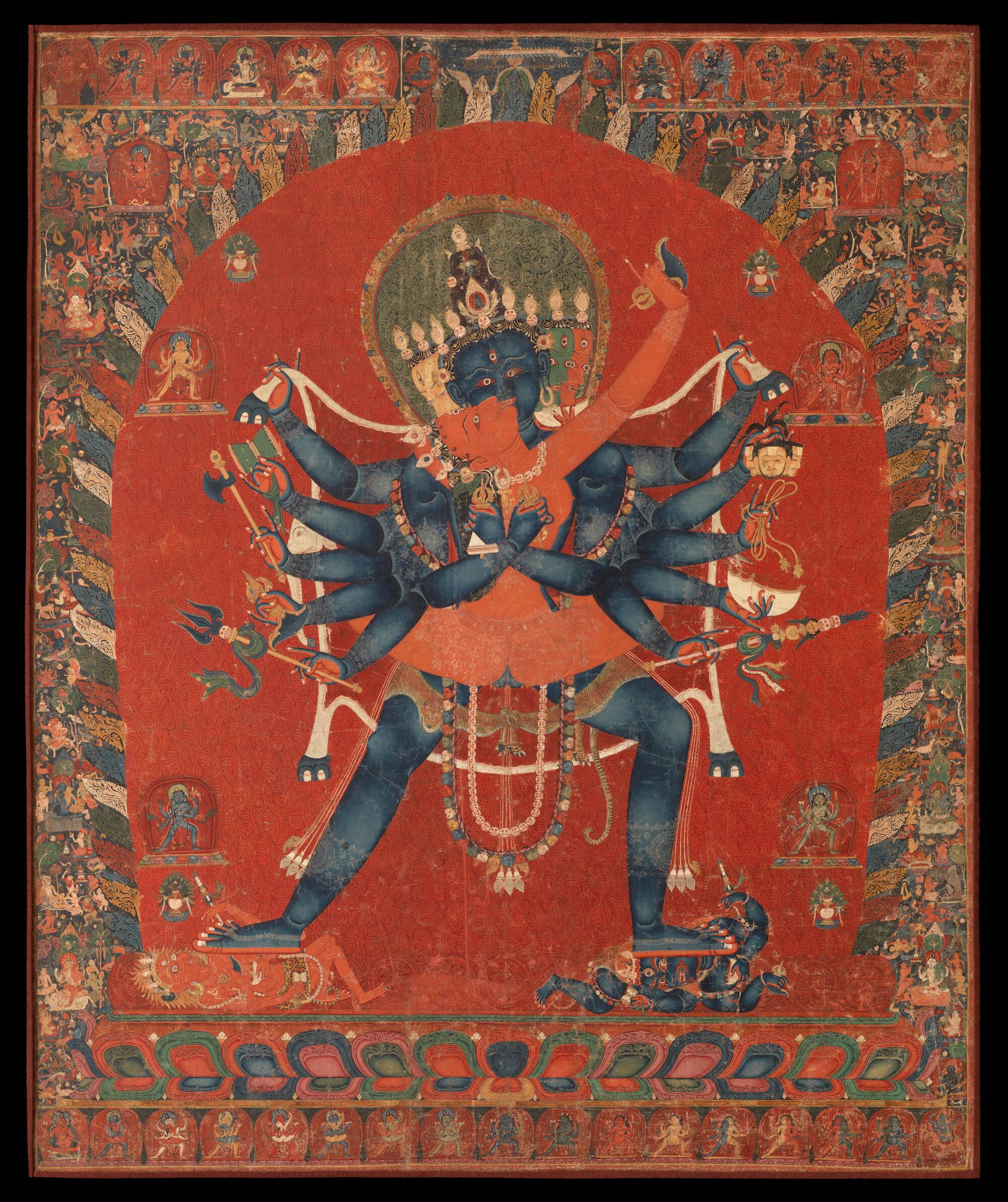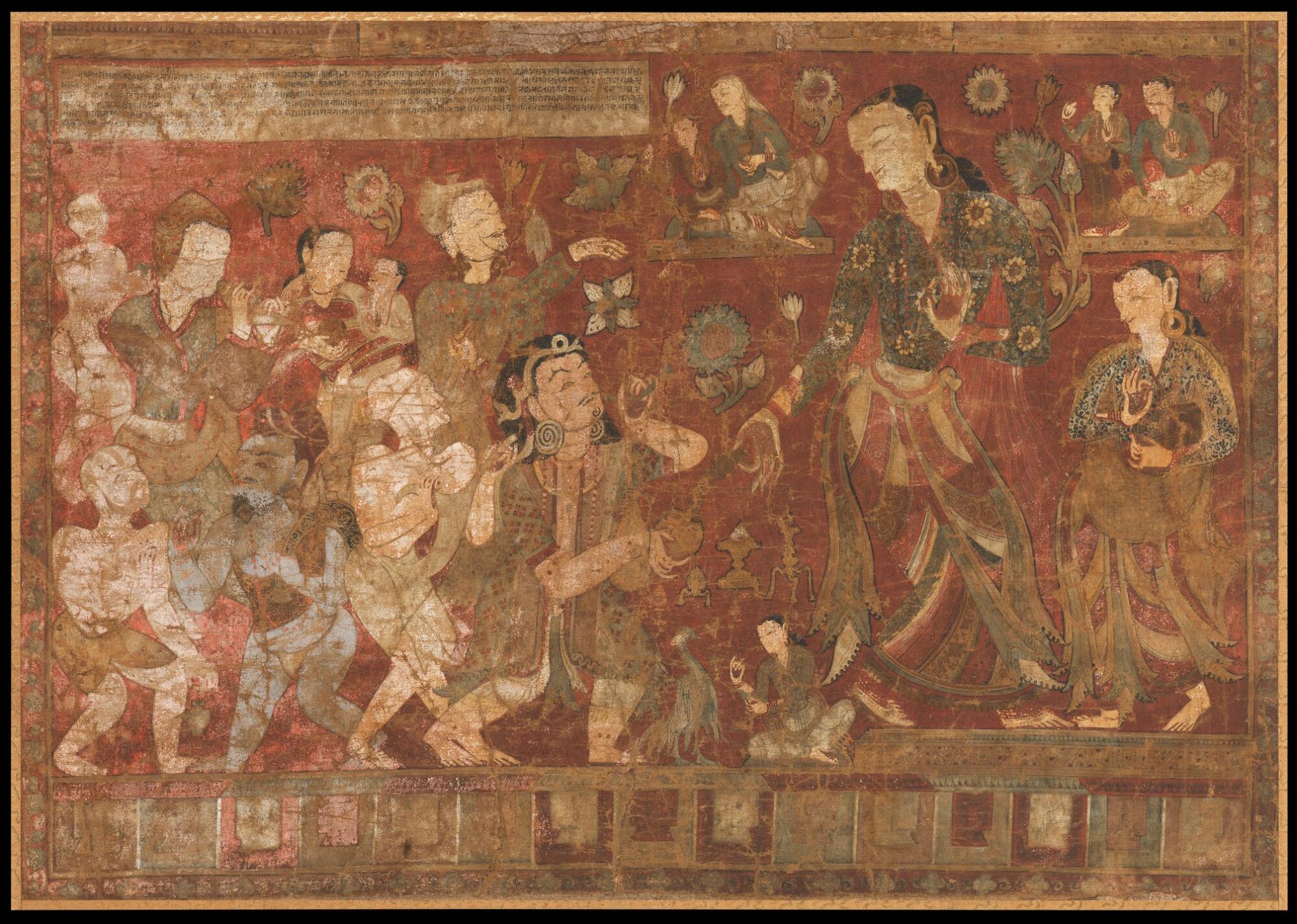“Realms of the Dharma: Buddhist Art Across Asia” is a big and fascinating presentation that features among the most splendid sculptures and work within the everlasting assortment of the Los Angeles County Museum of Artwork. It’s nice to see these works once more.
A lot of the artwork was packed up round eight years in the past in preparation for the demolition of the museum’s authentic campus and development of a brand new everlasting assortment constructing. The present providing of round 180 objects, put in within the short-term exhibition areas of the Resnick Pavilion, is a model of what was then despatched on tour, offered in 2018 at Mexico Metropolis’s incomparable Nationwide Museum of Anthropology. (LACMA Deputy Director Diana Magaloni was former director there.) Subsequent deliberate journey to artwork museums in Texas and the Pacific Northwest had been derailed by the COVID-19 pandemic, so the work went again into storage. It has been unavailable for hometown public viewing for a really very long time.
Siddhartha Gautama is accepted by most students because the historic determine Shakyamuni Buddha, or sage of the Shakya clan, who was born in Nepal and lived in India across the fifth century BCE. Representations of the spiritual instructor began out as practically summary symbols a number of thousand years in the past — a starburst form inside a spiraling whorl, for instance, which configures an emanation of sunshine inside an everlasting circulate. A Bodhi tree would possibly sign the sacred place the place Buddha’s deep perception into enlightenment occurred, or a drawn or carved footprint could be suggestive of following a path.
“Jina Buddha Vairochana,” India, Kashmir area, circa 725-50; brass and silver.
(Museum Associates / LACMA)
However no biographical texts emerged for a number of hundred years after his demise. Legend and non secular doctrine intertwined over centuries, splintering and reconfiguring and taking up new dimensions as they encountered scores of established cultures throughout South and Southeast Asia and past — Daoist philosophy in China, say, or Shinto faith in Japan. Finally, figurative representations took form. Evidently, as they proliferated in what are fashionable Sri Lanka, Pakistan, Myanmar, Thailand, Indonesia, Cambodia, Korea and extra, Buddha took on a wide range of types. LACMA has scores of wonderful examples, giant and small.Typically, as in an beautiful eighth century brass and silver forged from Kashmir, simply 16 inches tall, he’s seated with legs crossed and fingers entwined, counting earthly parts like fireplace and water being absorbed into the thoughts. In Tang Dynasty China he sits remoted in regal splendor, like an emperor carved in timeless white stone atop an elegantly draped cushion.
Within the subsequent room, a sturdy Burmese Buddha sporting a clear garment of reddish lacquered wooden raises an oversize proper hand in a jumbo gesture of peace, extending an open left hand that appears caught in mid-motion. (There are scores of symbolic Buddhist hand gestures, known as mudras.) A life-size columnar determine carved from sober grey schist, acquainted from the Gandhara area of Pakistan, likewise raises a peace mudra, however right here the cascading folds of his tunic’s material sign a army historical past of Greco-Roman interactions courting to the expansionist conquests of Alexander the Nice.

“Buddha Shakyamuni,” Burma (Myanmar), circa thirteenth century; lacquered wooden.
(Christopher Knight / Los Angeles Occasions)
Any faith that’s 1000’s of years outdated and practiced in innumerable locations shall be past difficult in doctrine and nuance, and Buddhism is not any exception. Deciphering them here’s a scholar’s activity. The names of particular person artists are additionally largely misplaced to us. Nevertheless, what all these completely different iterations share stylistically, no matter no matter elaborations encompass the Buddha, is a way of secure, enduring calm on the core. Always idealized in his bodily options, he’s the residing embodiment of the irresistible power paradox — an immovable energy and an unstoppable object unexpectedly.
Additionally on view are ritual instruments, like a jewel-encrusted crown, ceremonial knives and a stunning providing cupboard adorned with work of fierce, glowering demons that warning anybody who would possibly dare to disturb regardless of the cabinet holds. Again off!
Sculptures and work of poets, lamas, deities and particularly bodhisattvas — earthly helpers who’ve postponed their very own entry into nirvana, the place struggling disappears, to be able to assist others discover their approach — are practically as quite a few and diverse as Buddha Shakyamuni himself. Some are wildly extravagant, proliferating heads and arms into delirious phantasms of a number of character and manifold temperaments.An astounding fifteenth century portray on cotton fabric is a fiery picture of sexual coupling between deities, a crimson feminine determine with each legs wrapped round an ashy blue man. He stands on one straight leg with the opposite athletically bent, forming a strong stance designed to stabilize an ecstatic act of energetic intercourse.

“The Buddhist Deities Chakrasamvara and Vajravarahi,” Tibet, circa fifteenth century; pigments on cotton.
(Museum Associates / LACMA)
Like fluttering wings, his 12 elegantly splayed arms wield an array of esoteric symbols round her excited physique, whereas her single arm raises what seems to be a ritual blade excessive overhead. His flaming-eyed face is frontal, hers is overlaid in good profile. The shrewd composition abuts their lips, in order that they’re nearly to the touch in a kiss. Chakrasamvara, the blue-man emblem of compassion, is being embraced by his consort, Vajravarahi, vibrant crimson image of knowledge, in a spectacularly explosive show whose arrested design appears meant as a spur to deep meditation. They’re on the brink, and so, it’s to be hoped, are we.
The set up of “Realms of the Dharma” is fairly simple. The primary part introduces Siddhartha Gautama. A number of wall texts define primary Buddhist ideas and the faith’s two main types — Theravada (or monastic) and Mahayana (kind of “Buddhism for all”). From there, most objects are clustered by easy chronology and the area the place they had been made. That organizational scheme for such diverse artworks is commonplace for everlasting museum collections.
It’s reasonably uncommon at LACMA, although, given the timing. Earlier this month, previews had been held of the empty new constructing for the everlasting assortment, the David Geffen Galleries, explicitly designed to switch chronology and geography with artwork clustered by theme. Press supplies for “Dharma” counsel it’s a thematic bundle, with the exhibition as a method to find out about Buddhism. That reduces artwork to illustration, however fortunately the set up doesn’t come throughout that approach.

“Probably Shakyamuni, the Historical Buddha,” China, Tang Dynasty, circa 700-800; marble.
(Christopher Knight / Los Angeles Occasions)
Artwork museums are nice locations to find out about artwork — about the way it’s made, by whom and why — however not so nice for spiritual schooling. “Realms of the Dharma: Buddhist Art Across Asia” and its good-looking scholarly catalog, written by LACMA curator Stephen Little and former affiliate curator Tushara Bindu Gude, are good at that. However would an American artwork museum ever do a present on the theme of, say, “Transubstantiation: Catholic Art Across Europe and the United States,” to be able to train the varied subtleties and dynastic refinements of a perception within the conversion of bread and wine into flesh and blood? In all probability not. Except for making an attempt to wedge such wildly disparate Catholic artists as Fra Bartolomeo, Paul Cézanne, Tsuguharu Foujita and Andy Warhol right into a single coherent exhibition, lowering artwork to illustration simply undermines it.
The temptation to border Buddhist artwork that approach is definitely a perform of the faith’s unfamiliarity, its “exoticism,” besides in shallow popular culture phrases. Of the roughly half-billion Buddhists worldwide, lower than 1% of Individuals establish with it. In line with a captivating March research from the Pew Analysis Middle, Buddhism is immediately second solely to Christianity in experiencing particularly giant losses in adherents globally, with former followers switching to different faiths or, extra usually, now expressing no spiritual affiliation in any respect. The bulk dwell in California, a main entry level for Asian immigration to the USA, however barely 100,000 Buddhists are estimated to apply in Los Angeles.
Additionally helpful for museum audiences for a everlasting assortment present could be some acknowledgment of complicated points across the historical past of this sacred artwork’s possession. A couple of LACMA work has been contested as stolen, together with a powerful fifteenth century portray from Nepal of an vital Buddhist non secular grasp named Vanaratna. LACMA purchased the portray in 1977, when amassing requirements had been very completely different than they’re now. The wall label, with out making a definitive declaration, could be an excellent place to introduce the vital topic of case-by-case provenance analysis, however the topic is ignored.

“The Mahasiddha (Great Adept) Vanaratna (1384-1468) Receiving Initiation From Sita Tara,” Nepal, 1469; pigments on cotton
(Museum Associates / LACMA)
“Realms of the Dharma” will stay on view for a yr, closing in July 2026. Which means LACMA’s Buddhist masterworks received’t be within the Geffen constructing when it debuts in April subsequent yr, or anytime quickly after that. (Architect Peter Zumthor is testing paint glazes for among the Geffen’s all-concrete partitions, though a ultimate determination on whether or not so as to add colour has not been made.) The present is sensitively put in in Resnick. Given the artwork’s practically decade-long hiatus from L.A., it’s price visiting greater than as soon as throughout the subsequent a number of months, earlier than it disappears once more.
‘Realms of the Dharma: Buddhist Artwork Throughout Asia’
The place: LACMA, 5905 Wilshire Blvd., L.A.When: By means of July 12, 2026; closed WednesdaysAdmission: $23-$28; reductions for teenagers and seniorsInfo: (323) 857-6000,www.lacma.org


